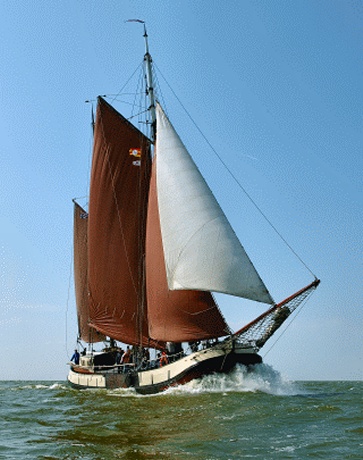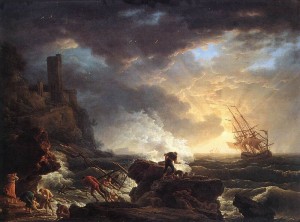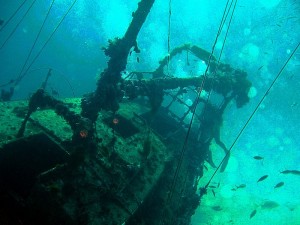HOT NEWS !
Stay informed on the old and most recent significant or spectacular
nautical news and shipwreck discoveries

-
Imperial flotilla found on seabed of Gulf of Finland
- On 06/02/2009
- In Parks & Protected Sites
- 0 comments

From Russia-IC
An unexpected find was discovered by scuba divers in the Gulf of Finland: at the depth of 50 meters they found six ships, one of them dating to the epoch of Peter the First.
The divers were examining the bottom in the area of the future gas main “The Nord Stream”. While looking for mines and torpedoes, they all of a sudden came across the fleet of six ships.
Out of all the discovered ships it is, a Russian military transport ship built according to Dutch design, which is of greatest interest to modern historians.The experts assume it is most probably a ship from Peter’s fleet and it sank during the cruise of Russian fleet to Finland in 1713. The ship, which is almost 17 meters long, has remained nearly intact.
-
Dominican Government, sunken treasure hunters mum on deals
- On 06/02/2009
- In Treasure Hunting / Recoveries
- 0 comments
From Dominican Today
The salvage company Deep Blue Marine has been diving after wrecks for treasures, including the French Scipion, an 18th century ship that sank off the Dominican Republic northern coast, although the Caribbean nation’s government has kept mum on this operation and another similar venture by the company Marine Exploration.
Utah-based newspaper sltrib.com reports that Deep Blue Marine is bringing up cannons, guns, plates and other artifacts.
“That's what it does normally, look for treasure in the world's oceans. As with all treasure divers, we all hope to find gold and silver," said Allan Baird, Deep Blue Marine's project manager.
Baird, said the company based in Midvale, Utah will be splitting the booty from its current salvage operation with the Dominican Government, and taking some of the artifacts to make jewelry to sell to museums and collectors."We're getting ready to go on out with some of our things, including one of our huge, huge cannons that we have on site."
-
Wreck of HMS Victory found in English Channel
- On 06/02/2009
- In Treasure Hunting / Recoveries
- 0 comments

By Thomas H. Maugh II
American salvagers say they have discovered the long-sought wreck of HMS Victory, the mightiest and most technologically advanced warship of its time, which sank during a violent storm in the English Channel in 1744.
Armed with as many as 110 massive bronze cannons and carrying a crew of 900 men and 100 supernumeraries, the Victory was lost with all hands and reportedly with a treasure of gold bullion whose value is estimated at $1 billion.
In a news conference Monday in London, Greg Stemm, chief executive of Odyssey Marine Exploration in Tampa, Fla., said the company found the remains in 330 feet of water more than 60 miles from where the vessel was thought to have sunk -- exonerating the captain, Sir John Balchin, from the widespread accusation that he had let it run aground through faulty navigation.
"This is the naval equivalent of the Titanic, perhaps even more important than the Titanic," said marine archaeologist Sean Kingsley, director of Wreck Watch International, who consulted with Odyssey on the find."It's the only intact collection of bronze guns from a Royal Navy warship in the world."
-
Preservation of sunken British warship urged by UN cultural agency
- On 06/02/2009
- In Famous Wrecks
- 0 comments
From U.N News center
The head of the United Nations cultural agency today called for the preservation of a British man o’war sent to the bottom of the English Channel by a storm in 1744 with all hands and, it is said, a sizeable gold treasure.
The discovery of the wreck of the HMS Victory was announced on 2 February by the explorers who found it off the Channel Islands, according to the UN Educational, Scientific and Cultural Organization (UNESCO).
“I am delighted that such an exceptional example of underwater heritage has been located. The cultural and scientific value of this artefact is considerable,” said Koïchiro Matsuura, UNESCO’s Director-General.
He said that its preservation was particularly important in light of UNESCO’s Convention on the Protection of the Underwater Cultural Heritage, which entered into force last month after it was ratified by 22 States.
“In the spirit of the Convention adopted by UNESCO in 2001, I trust that all parties concerned will take the necessary measures to ensure this important vestige of British naval history is safeguarded and given appropriate attention, not used for commercial gain,” he said. -
Why I oppose commercializing underwater wrecks
- On 05/02/2009
- In Underwater Archeology
- 0 comments

From Archaeology
The glee that I took last week in seeing the UNESCO Convention for the Protection of the Underwater Cultural Heritage coming into force seems to have provoked much puzzlement on the part of readers.While most respondents agreed that historic shipwrecks scattered on the ocean floor deserved careful archaeological study, many wondered why academic or non-commercial archaeologists should have exclusive right to the world’s underwater heritage.
“Why is it wrong for a private company,” wrote one thoughtful reader, “if it did the excavation the same way a museum or university would have done it, and disseminated the information about it (whether in AJA or on Discovery Channel), why is it wrong for them to keep what they found ?Why is that any different from the many, many boxes of artifacts that museums have stowed away [and] gather dust not to be seen by anyone?”
There are several points here which I think are important. To begin with, I have yet to come across a treasure-hunting company operation that even comes remotely close to most government- or university-sponsored excavations.Excavating a shipwreck is a very time-consuming and laborious operation. Quite apart from the slow, tedious work of excavating and meticulously recording an underwater site (work that takes even longer at the bottom of the sea than it does on land), there is the delicate, decade-long or more business of stabilizing and conserving artifacts removed from the water.
Then there is the analysis and publication of the finds.
-
A victory in the war of wrecks
- On 05/02/2009
- In Underwater Archeology
- 0 comments

From Archaeology
I am feeling immensely cheered. It’s not just that I had a fine holiday season with family and friends, and that I’m now completely revved up for another year of exploring the labyrinthine world of archaeology.Something grand has happened today: after eight years of immensely hard work on the part of underwater archaeologists and diplomats around the world, the UNESCO Convention on the Protection of the Underwater Cultural Heritage enters into force.
Nautical archaeologists have long sought to put an end to looting and extend some form of legal protection to archaeological sites on the bottom of the sea.
It has been and continues to be a herculean fight, one that they’ve waged against increasingly sophisticated treasure hunters and—more depressingly still—against governments around the world that have made Faustian pacts with treasure hunters, allowing them to plunder historic wrecks in exchange for a cut of the profits.
Perhaps you think that only impoverished third-world countries would agree to such deals, but you would be very mistaken. The United Kingdom, for example, a nation whose illustrious history rests on the strength of its Royal Navy, betrayed its past in exactly that way in September 2002.
To its great shame, it secretly issued a contract to the American treasure-hunting firm, Odyssey Marine Exploration, to salvage one of its historic, treasure-bearing warships, HMS Sussex, from waters off the Gibraltar coast. -
Maryville diver helps bring closure to shipwreck families in Michigan
- On 05/02/2009
- In Wreck Diving
- 0 comments

By Beth Haynes
On November 18, 1958, the Carl D. Bradley, a Great Lakes freighter, was heading home after her last run of the season.
"It was snowing. It was incredibly cold," explains diver Alan Williams of Maryville.
The Carl D. Bradley was caught in the middle of a fierce storm. Mother nature was too strong. The ship broke in two and sank. Incredibly, two people survived. Of the 33 that perished, the majority were from the tiny town of Rogers City, Michigan.
"We're talking a town less than 10,000 people. Then, all of a sudden, 33 people are gone--everyone knew everyone. It was a major disaster for this town."
Today, the Carl D. Bradley is a watery grave on the bottom of Lake Michigan. After all this time, the pain is still very real.
"This is called a re-breather and this is what we used during the dives, because of the extreme depth," says Williams, demonstrating equipment at Rhea's Dive Shop in Maryville. -
Finding treasure and losing history
- On 05/02/2009
- In Treasure Hunting / Recoveries
- 0 comments
By Zach Zorich
For more than a year, the marine salvage company Odyssey Marine Exploration has been embroiled in a legal battle with the government of Spain over the rights to a site they call "Black Swan," which might hold the most valuable sunken treasure ever recovered.At the same time, underwater archaeologists working with the United Nations Educational, Scientific, and Cultural Organization have succeeded in creating a treaty that bans treasure hunting in the territorial waters of signatory nations (see "A Victory in the War of Wrecks.")
But you won't hear much about any of that in Treasure Quest a new series on Discovery Channel (Thursdays at 10pm) that takes a completely uncritical look at Odyssey's business of finding, removing, and selling archaeological artifacts from the ocean floor.
As the UNESCO treaty takes effect and legal pressures mount against Odyssey, the Discovery Channel is cashing in on the business of systematically looting shipwrecks.
The first episode opens with a scene at "Black Swan", where the Odyssey crew gleefully scoops up gold and silver coins using a submersible remotely operated vehicle (ROV). Odyssey claims that "Black Swan" is not a shipwreck, it is a debris field--a site where treasure may have been thrown overboard perhaps from a ship that was in danger of sinking and needed to quickly off-load a large amount of weight.
If this claim is true, then the treasure could be considered abandoned property. Because the treasure was found international waters, it would belong solely to Odyssey.
The Spanish government isn't buying this story. They believe that Odyssey has found the wreck of Nuestra Senora de la Mercedes , a ship that sunk in 1804 carrying a large amount of coins.
They are demanding to know the site's location and to be able to inspect the artifacts that Odyssey has recovered.
If the coins came from Mercedes then the treasure is Spanish property and Odyssey might not get any of the treasure.
On the other hand, the judge in the case could give Odyssey a salvage award that could be more than 90 percent of the treasure as compensation for its recovery.
Treasure Quest reveals very little about the site (Odyssey considers even basic information about the site proprietary).
The legal battle is only briefly mentioned during the first episode, but the scene at "Black Swan" does show that the program's producers are more interested in the search for gold than history.